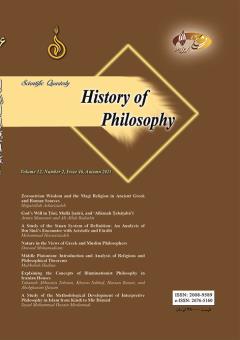-
-
List of Articles
-
Open Access Article
1 - ُُEditor's Note
Hossein Kalbasi Ashtari -
Open Access Article
2 - Zoroastrian Wisdom and the Magi Religion in Ancient Greek and Roman Sources
Hojjatullah Askarizadeh -
Open Access Article
3 - God’s Will in Ṭūsī, Mullā Ṣadrā, and ‘Allāmah Ṭabāṭabā’ī
Armin Mansouri Ali Alahbedashti -
Open Access Article
4 - A Study of the Sinan System of Definition: An Analysis of Ibn Sīnā’s Encounter with Aristotle and Fārābī
Mohammad Hosseinzadeh -
Open Access Article
5 - Nature in the Views of Greek and Muslim Philosophers
داود محمدیانی -
Open Access Article
6 - Middle Platonism: Introduction and Analysis of Religious and Philosophical Theorems
Mahbobeh Hadina -
Open Access Article
7 - Explaining the Concepts of Illuminationist Philosophy in Iranian Houses
Takameh Abbasnia Tehrani Khosro Sahhaf Hassan Rezaei Abolghasem Qavam -
Open Access Article
8 - A Study of the Methodological Development of Interpretive Philosophy in Islam from Kindī to Mīr Dāmād
Seyed Mohammad Hosain Mirdamadi
-
The rights to this website are owned by the Raimag Press Management System.
Copyright © 2017-2025







